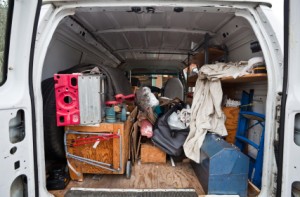11th August, 2010
Over the last 10 years much has been done within the Light Commercial Vehicle (LCV) industry to help reduce the number accidents. ABS breaks and traction control are now fitted as standard on many of UK panel vans. Manufacturers are also providing such items as airbags and crumple zones to lessen injuries.
 However, The Freight Transport Association (FTA) are tackling a road safety issue which has been largely ignored up until now – the potential injury caused by the load which the van is being used to transport!
However, The Freight Transport Association (FTA) are tackling a road safety issue which has been largely ignored up until now – the potential injury caused by the load which the van is being used to transport!
Fleet News (www.fleetnews.co.uk) recently featured an article outlining the FTA’s approach to the matter, which will be examining an employer’s duty of care to its employees such as;
- Restraining of cargo and fixed equipment
- Retro-fitment of driver aids
- Alterations to the vehicle structure
- Fitment of racking systems and internal and external load carrying.
A TRL spokesman said: “The performance of these items in normal driving conditions poses little risk.
However in a crash, the forces experienced mean that the performance requirements of vehicle modifications and restraining systems needs to be considerably more robust – as much as 20 times greater.
As an example to show that things don’t always work as the man in the street would imagine, TRL testers bought a typical roof-mounted plastic pipe carrier, bolted it to a van roof and filled it with copper pipes before crashing it at 30mph. The plastic end of the carrier simply snapped off and the pipes flew out….In a real-life crash, they could have hit and killed a pedestrian or occupants of the car in front.”
The article goes on to highlight some basic safety precautions employers can make in order to reduce the risk vehicle loads can present in the event of a collision
Top tips for drivers
1. Adhere to all company policies concerning the driving of vehicles, working practices and the loading of vehicles
2. Do not overload storage systems or vehicles and follow company/supplier guideline on this point
3. Do not place unsecured objects directly behind where occupants are likely to sit
4. Place heavy objects as low as possible in the vehicle stowage area
5. Do not place unsecured objects directly in the occupant compartment of the vehicle
6. Stow tools and equipment in racking systems if provided
7. Use appropriate tie-downs, lashing and netting to secure larger loads and equipment in the rear of the vehicle
8. Check that tie-down points and lashing systems are not damaged or worn and have them fixed or replaced if they are
9. Check load restraints and lashings shortly after beginning a journey or after any heavy braking to ensure the motion of the vehicle and the settling of the load have not loosed it
10. If you have any concerns about modifications that have been made to a vehicle, these should be raised with the fleet manager
Read the full article here:
http://www.fleetnews.co.uk/vans/article/load-safety-means-road-safety/35960/